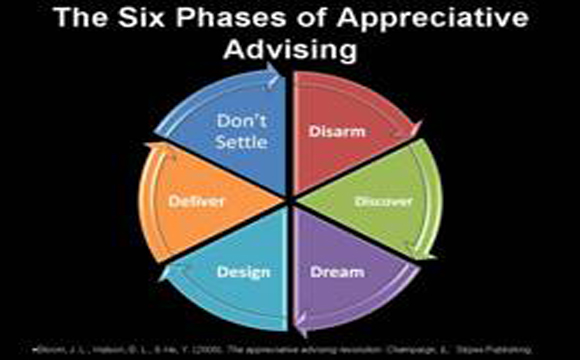How can Appreciative Advising help students?

During the 2013 Blueprint for Excellence National Conference, Dr. Jennifer Bloom, a clinical professor at the University of South Carolina, indicated that K-12 and higher education officials are often speaking different languages instead of learning from each other on how to engage students and parents. She feels this can account for some of the academic achievement gap between K-12 and higher education. With a high dropout rate at the secondary and postsecondary levels, the critical questions to be asked are: How can Appreciative Advising help students? What is Appreciative Advising? How can educational institutions use Appreciative Advising? What is the success of the University of North Carolina at Greensboro using Appreciative Advising? What are the six phases of Appreciative Advising?
Educational Institutions are searching for positive ways to increase student retention and success rates. As an alternative solution to academic success, Bloom talked about how she teaches faculty members and professional advisors across the country on how to be better advisors through a theory-to-practice framework called Appreciative Advising (AA). Appreciative Advising is the intentional collaborative practice of asking positive, open-ended questions that help student optimize their educational experiences and achieve their dreams, goals and potentials according to Bloom.
While applicable for all educational institutions to create positive organizational change, there are eight higher education institutions that currently utilize the Appreciative Advising framework. They include University of North Carolina at Greensboro (UNCG); University of North Carolina at Wilmington; Indiana University-Purdue University Indianapolis; University of South Carolina at Columbia; Miami University Hamilton; Eastern Illinois University; Prairie State College and Grand Valley State University.
Institutions vary on how they use the Appreciative Advising framework, however, some example include using it as an advising syllabus, incorporating the content in a first-year experience course or summer bridge program or focusing on the face-to-face advising appointment. Eastern Illinois utilizes AA electronically. UNCG has applied Appreciative Advising for academic probation students utilizing three mandatory advisory sessions and the use of AA questions in weekly reflection and discussions. As a result, the retention of these students improved by 20 percent since the program was implemented.
Building a strong relationship with students to help them optimize their educational experiences and achieve their dreams, goals and potentials is the aim of Appreciative Advising. Having resources at educational institutions without the engagement or involvement of students is counterproductive. AA focuses on researched-based strategies to help educational institutions deliver the best quality of education for students to succeed. As such, its framework comprises of six phases: Disarm, Discover, Dream, Design, Deliver and Don’t Settle.
According to Bloom, Disarm involves making a positive first impression with students and allaying any fear or suspicion they might have of meeting with the advisor. Discover is spent continuing to build rapport with students and learning about the students’ strengths, skills and abilities. Dream involves uncovering students’ hopes and dreams for their futures. Design co-creates a plan for helping students accomplish their dreams. Deliver is the implementation phase where students carry out their plan and the advisor’s role is to support them as they encounter roadblocks. Don’t Settle involves challenging the students to achieve their full potential.
Through an Appreciate Advising Institute, participants can learn how to use the six phases of Appreciative Advising to help their students and themselves optimize their educational experiences. For additional information about the Appreciative Advising framework, go to: http://www.ed.sc.edu/conferences/appreciativeadvising/Default.asp
Dr. Ronald Holmes is the author of four books, “Education Questions to be Answered,” “Current Issues and Answers in Education,” “How to Eradicate Hazing and “Professional Career Paths.” He is publisher of “The Holmes Education Post,” an education focused Internet newspaper. Holmes is a former teacher, school administrator and district superintendent. He can be reached at [email protected].

